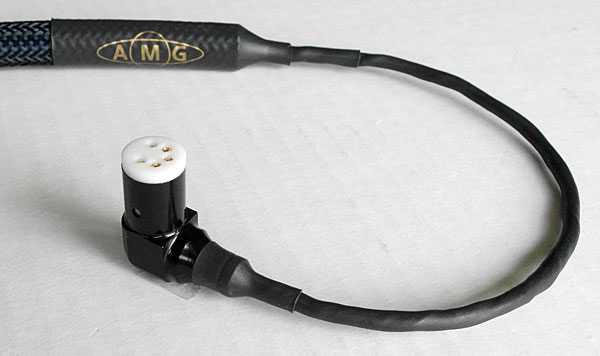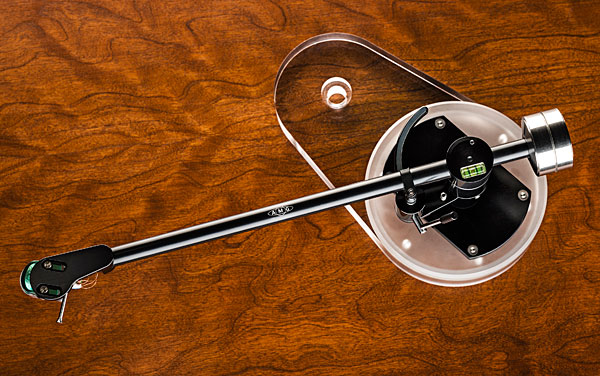| Columns Retired Columns & Blogs |
Listening #142 Page 2
Speaking of which, the 9W2's azimuth is adjustable, by means of a setscrew that contacts the top of the innermost vertical bearing wire, allowing that side of the armtube to move minutely up or down relative to the side that hinges on the outermost bearing wire. (A dedicated locking screw preserves the azimuth adjustment, which is set to neutral at the factory.) Equally clever is the AMG arm's antiskating mechanism, which is similar to that of the classic Decca International Pick-Up Arm. Both use a pair of opposed magnets: a stationary one in the armtube's bearing housing vs a movable one attached to the tonearm pillar. The movable magnet in the AMG has the advantage of being lockable, by means of a sliding setscrew. The Decca's antiskating mechanism has the advantage of being calibrated, howsoever fancifully, whereas the AMG's works by trial and error—a limitation exacerbated by its extremely small range of travel. Downforce in the AMG, also uncalibrated, is static, established by moving a nicely machined counterweight fore or aft.
The AMG arm's height is set in the usual manner—a grub screw in the arm-mount collet holds the tonearm pillar in place—and adjusted by means of a longish vertical setscrew that passes through a threaded hole in the arm's cueing gantry and bottoms out against the flat surface of the arm-mount collet. This is an arrangement we've seen in any number of older arms, but it works unusually well in the AMG for one very good reason: Notwithstanding its chunky appearance and apparently sturdy construction, this tonearm is surprisingly low in mass. The 9W2's effective mass is specified as only 9.1gm, and its mounting collet, though beautifully made, is also spare and light—something the LP12's suspension doesn't mind at all. Consequently, unlike Ike and Tina Turner's every endeavor, adjusting a cartridge's vertical tracking angle (VTA) with the AMG 9W2 was always nice and easy.
The 9W2's headshell, which is cemented in place, is a nicely machined chunk of aircraft aluminum, anodized black—which describes most elements of the arm, excepting its Teflon-isolated steel counterweight. The cartridge-mounting platform is the exact shape and size of a US 5¢ piece, and its cueing lever is removable. Speaking of levers, the 9W2's lift/lower mechanism is the usual sort, apparently bought in from whoever makes such things; otherwise, the 9W2 is entirely made—precision machinings included—by AMG, a company whose entrée to the world of domestic audio was their making of various component parts for other turntable and tonearm manufacturers.
Drill and practice
Apart from its beautiful build quality and surprising lightness, something else about the AMG tonearm struck me when I freed it from its nice wooden storage box: Although it has an SME-standard five-pin DIN connector at the bottom of its pillar, the 9W2 does not come with a tonearm cable. I placed a call to Garth Leerer of Musical Surroundings, which distributes AMG in the US, and he informed me that the 9W2 can be bought with any of three handmade cable options: Basic ($300), Standard ($600), and Reference ($1500). Not surprisingly, Leerer recommended I try the Reference version, which arrived a few days later.

That cable measured a robust 0.45" in diameter over most of its length and was rather stiff—yet its tonearm end was a 6.25" length of far more flexible cable, terminated in a Cardas right-angle DIN plug. Getting the Reference cable through the LP12's notorious cable-clamping P-clip was scarcely doable—the cable's flexible, small-diameter end was too short to reach all the way to the P-clip—but it was flatly impossible to get the fat cable through the cable opening machined into the Linn's wooden plinth, which I was unwilling to enlarge (nor was I asked to). There ensued one of those odd-looking but ultimately effective reviewer's kludges, this one requiring that I temporarily dispense with the LP12's fiberboard bottom cover, then raise the entire plinth above my equipment rack by a little more than ½". It worked.
Otherwise, installation and setup were unremarkable. The 9W2 required the drilling of a single 30mm hole with its center precisely 211mm from the center of the platter bearing, plus three holes to accommodate the collet's M4 mounting screws. (I had somehow got the idea that the AMG arm can use the same armboard as a Rega RB300, but it can't.) I measured carefully, and, with my Miyabi 47 cartridge positioned all the way forward in the 9W2's slotted headshell, my efforts were rewarded with perfect alignment—according to my preferred dB Systems protractor, which is based on traditional Baerwald geometry. Nice. And. Easy. Incidentally, the AMG arm is built with a recess at the precise center of its bearing housing, to ease its use with those alignment aids that require such a thing; that and the subminiature spirit level built into the bearing cap are nice touches indeed.

Good alignment was not my only reward: I was treated to some of the finest sound I've heard from this or any other LP12. Nick Drake's casually intricate fingerpicking in "From the Morning," from his Pink Moon (LP, Island 1745697), was every bit as propulsive as it should be. Granted, this musical performance doesn't have a great deal of obvious drive—the likes of which might, one suspects, be well served by a record player more capable of communicating same. But it does have a certain subtle momentum, a sea-lapping-at-the-shore insistence that a playback system either does or does not get right. The Linn-AMG combination served it extremely well.
Even better, this combination got across the subtler aspects of Drake's singing, in particular the faltering of pitch at the ends of certain lines, and the innocent, almost bland tone he uses—ironically, perhaps—to deliver a lyric that is both uplifting and mildly disturbing. And with the AMG arm in place of the fine old Rega RB300, those aspects were more audible, and easier to understand and enjoy.
The Linn-based player sounded flatter, less colorful, and less expressive than my usual Garrard 301–based player with Janet Baker's 1967 recording, with the Melos Ensemble of London, of songs by Ravel, Chausson, and Delage (LP, L'Oiseau-Lyre SOL 298). The Linn communicated far less force and touch in the instrumentalists' note attacks. Still, the LP12 did what it has virtually always done best: It latched on to lines of notes and presented them not as sound but as music, with senses of tempo and pitch that were unerringly right—as was especially easy to hear in the languorous, broadly paced melodies of "Placet futile," from Ravel's Trois poèmes de Stéphane Mallarmé. Indeed, the Linn was far better at this when I used the AMG tonearm in place of my trusty Rega.
Significantly, the AMG tonearm worked exceptionally well with the Miyajima Laboratory Premium BE Mono: a colorful, impactful, notably low-compliance cartridge that also sounds wonderful in my Thomas Schick tonearm. Since the 12"-long Schick is of obviously higher mass, one might wonder how a 9" arm with an effective mass of 9.1gm could mate similarly well with a cartridge whose recommended downforce is a hefty 3.5gm. The answer is an unsurprising "I don't know"—perhaps someone whose understanding of Hooke's Law runs deeper than mine could offer an explanation—but I suspect it has something to do with the adaptability of the AMG's pseudo–torsion-bar bearing. Which, in a sense, isn't a bearing at all.
Loving me some Linn
Yes, I still prefer my combination of vintage Garrard 301 turntable, homemade plywood plinth, EMT 997 tonearm, and EMT TSD 15 pickup. Although my LP12-based player, like virtually any other well-installed LP12-based player, makes an insightfully, pleasantly, altogether entertainingly musical sound, my Garrard rig does the same with considerably more force, touch, color, and sheer pull. And believe me, I've worked hard to isolate that point of view from the fact that, after my own decades in the flat-earth trenches, I'm weary of much of the sheer nonsense surrounding the LP12: the weak explanations for its most poorly thought-out elements, the fact that certain upgrades seem more like Band-Aids than integral parts of the design, the ridiculously high prices of certain other of its upgrades, the fanboys at demonstrations who bounce up and down in their seats when the LP12 is playing but remain stock-still when it's the competition's turn, and, most of all, the whole culture of selling by swagger.
Not all of the above can be laid at Linn's doorstep, and it isn't fair to blame the sins of its Mooniest adherents on the Linn LP12 itself, which remains not only a well-made, well-designed, reliably musical product but, in its most basic guise, a distinctly good value. And the LP12 stands above virtually every other product in contemporary domestic audio in being a stunningly classy industrial design in which the existence of every visual element is motivated by a good or at least entertaining engineering reason. It's as if Saab still made the old 900, Fender still made the pine-bodied Esquire, Brooks Brothers still made the undarted suit jacket, Coke still used sugar instead of high-fructose corn syrup. I may no longer consider the Linn LP12 the best for me, but I still consider it the most significant piece of hi-fi history still in production.
And the AMG 9W2 tonearm? It's the first Linn-friendly arm I've heard that has made me stop sobbing about the demise of the Naim Aro: a considerable feat.
- Log in or register to post comments




































